Developing Individual, Teams and Organizations Report - HR Development
VerifiedAdded on 2020/07/23
|18
|4112
|75
Report
AI Summary
This report delves into the crucial aspects of human resource development within an organizational context, specifically using TESCO as a case study. It begins by outlining the essential knowledge, skills, and behaviors required of HR professionals, emphasizing the need for a balance across these components. The report then presents a personal skills audit and a professional development plan for an existing HR officer, Jane Cambridge, highlighting her current proficiency and outlining areas for improvement through training and skill development in areas such as communication, data handling, and conflict management. The report then differentiates between organizational and individual learning, emphasizing the importance of continuous learning and professional development for both employees and the organization as a whole. It also explores the contribution of High-Performance Work (HPW) systems to employee engagement and competitive advantage, along with different approaches to performance management. Finally, it underscores the significance of organizational learning for TESCO's growth and the importance of training in building employee confidence and adaptability.
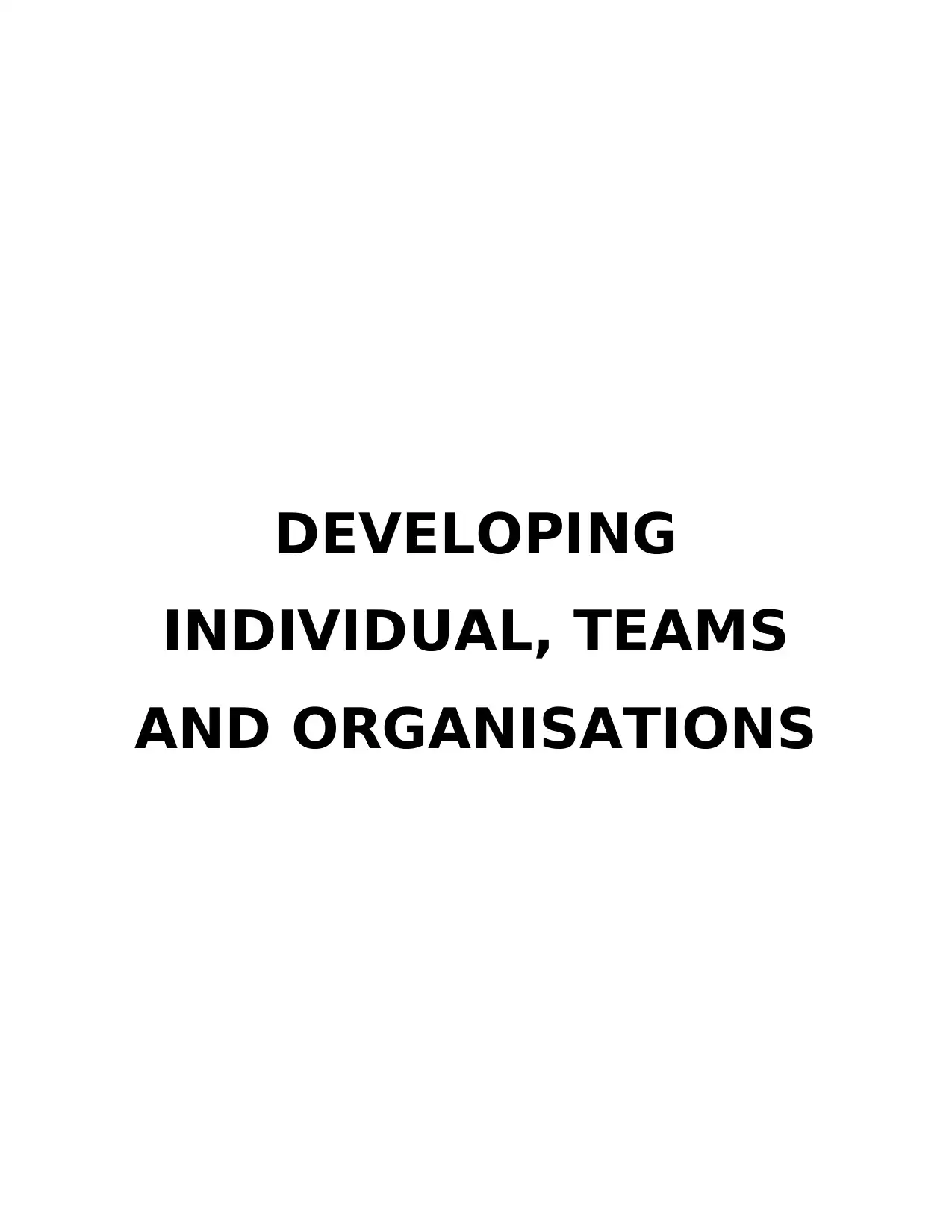
DEVELOPING
INDIVIDUAL, TEAMS
AND ORGANISATIONS
INDIVIDUAL, TEAMS
AND ORGANISATIONS
Paraphrase This Document
Need a fresh take? Get an instant paraphrase of this document with our AI Paraphraser
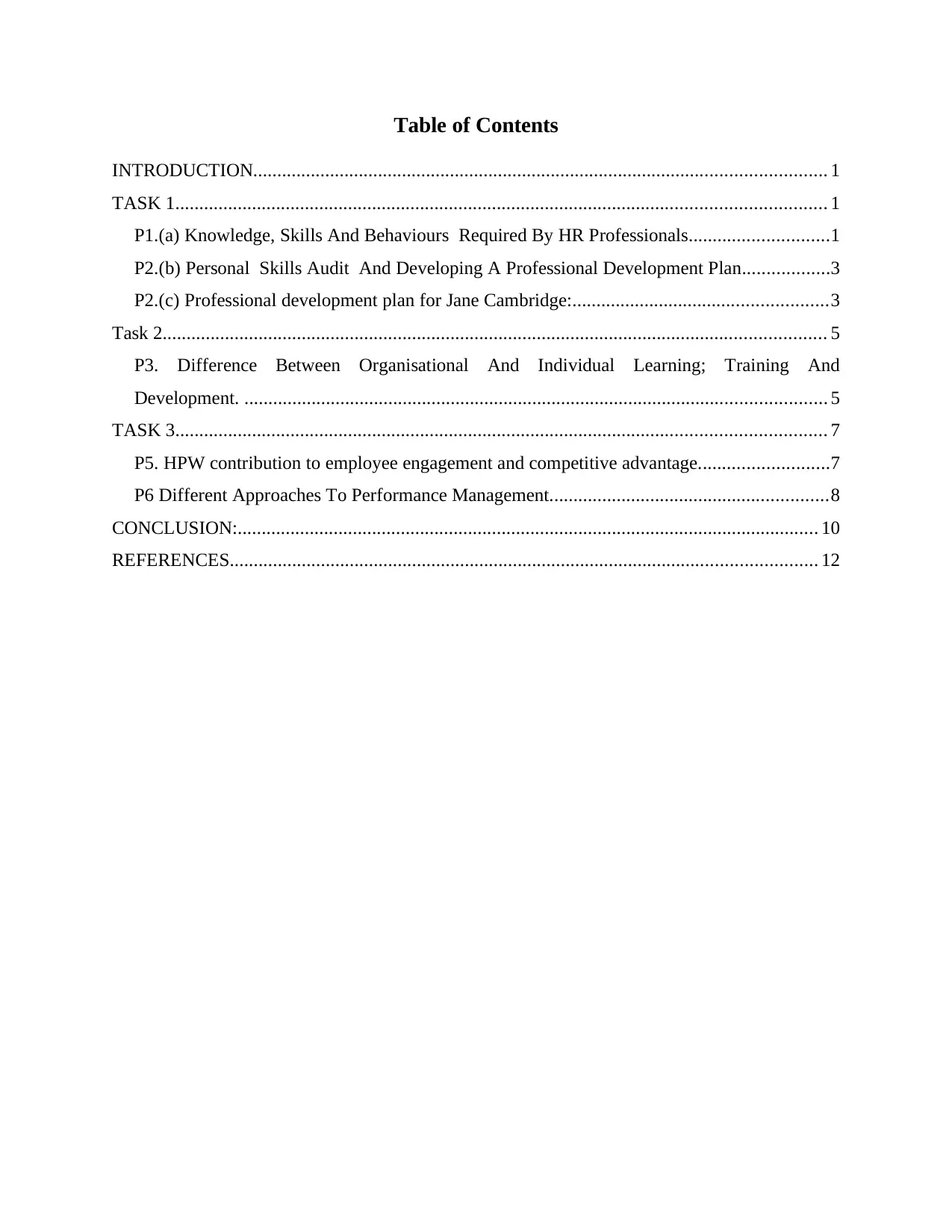
Table of Contents
INTRODUCTION....................................................................................................................... 1
TASK 1....................................................................................................................................... 1
P1.(a) Knowledge, Skills And Behaviours Required By HR Professionals.............................1
P2.(b) Personal Skills Audit And Developing A Professional Development Plan..................3
P2.(c) Professional development plan for Jane Cambridge:.....................................................3
Task 2.......................................................................................................................................... 5
P3. Difference Between Organisational And Individual Learning; Training And
Development. ......................................................................................................................... 5
TASK 3....................................................................................................................................... 7
P5. HPW contribution to employee engagement and competitive advantage...........................7
P6 Different Approaches To Performance Management..........................................................8
CONCLUSION:......................................................................................................................... 10
REFERENCES.......................................................................................................................... 12
INTRODUCTION....................................................................................................................... 1
TASK 1....................................................................................................................................... 1
P1.(a) Knowledge, Skills And Behaviours Required By HR Professionals.............................1
P2.(b) Personal Skills Audit And Developing A Professional Development Plan..................3
P2.(c) Professional development plan for Jane Cambridge:.....................................................3
Task 2.......................................................................................................................................... 5
P3. Difference Between Organisational And Individual Learning; Training And
Development. ......................................................................................................................... 5
TASK 3....................................................................................................................................... 7
P5. HPW contribution to employee engagement and competitive advantage...........................7
P6 Different Approaches To Performance Management..........................................................8
CONCLUSION:......................................................................................................................... 10
REFERENCES.......................................................................................................................... 12

·
·
·
·
·
⊘ This is a preview!⊘
Do you want full access?
Subscribe today to unlock all pages.

Trusted by 1+ million students worldwide
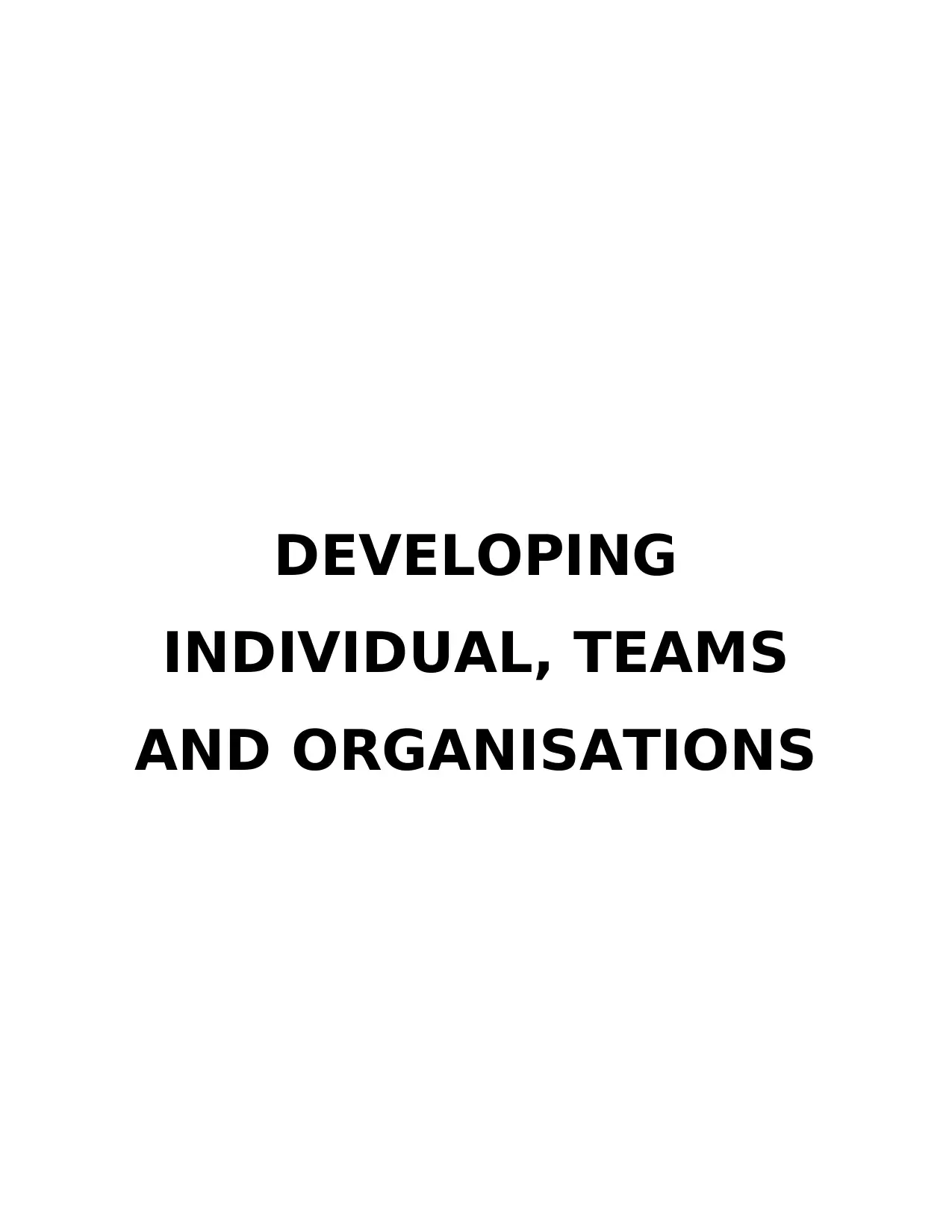
DEVELOPING
INDIVIDUAL, TEAMS
AND ORGANISATIONS
INDIVIDUAL, TEAMS
AND ORGANISATIONS
Paraphrase This Document
Need a fresh take? Get an instant paraphrase of this document with our AI Paraphraser

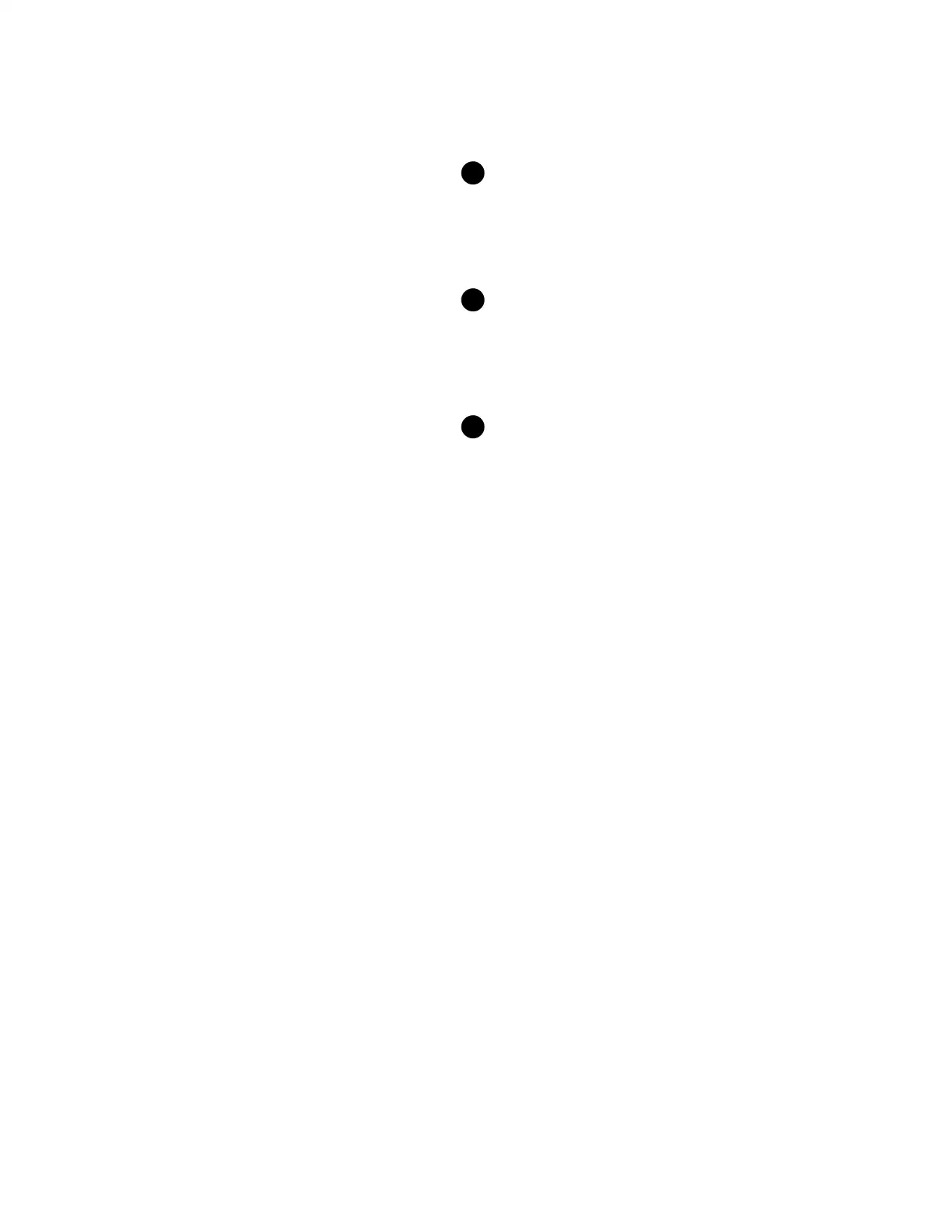
·
·
·
·
·
⊘ This is a preview!⊘
Do you want full access?
Subscribe today to unlock all pages.

Trusted by 1+ million students worldwide
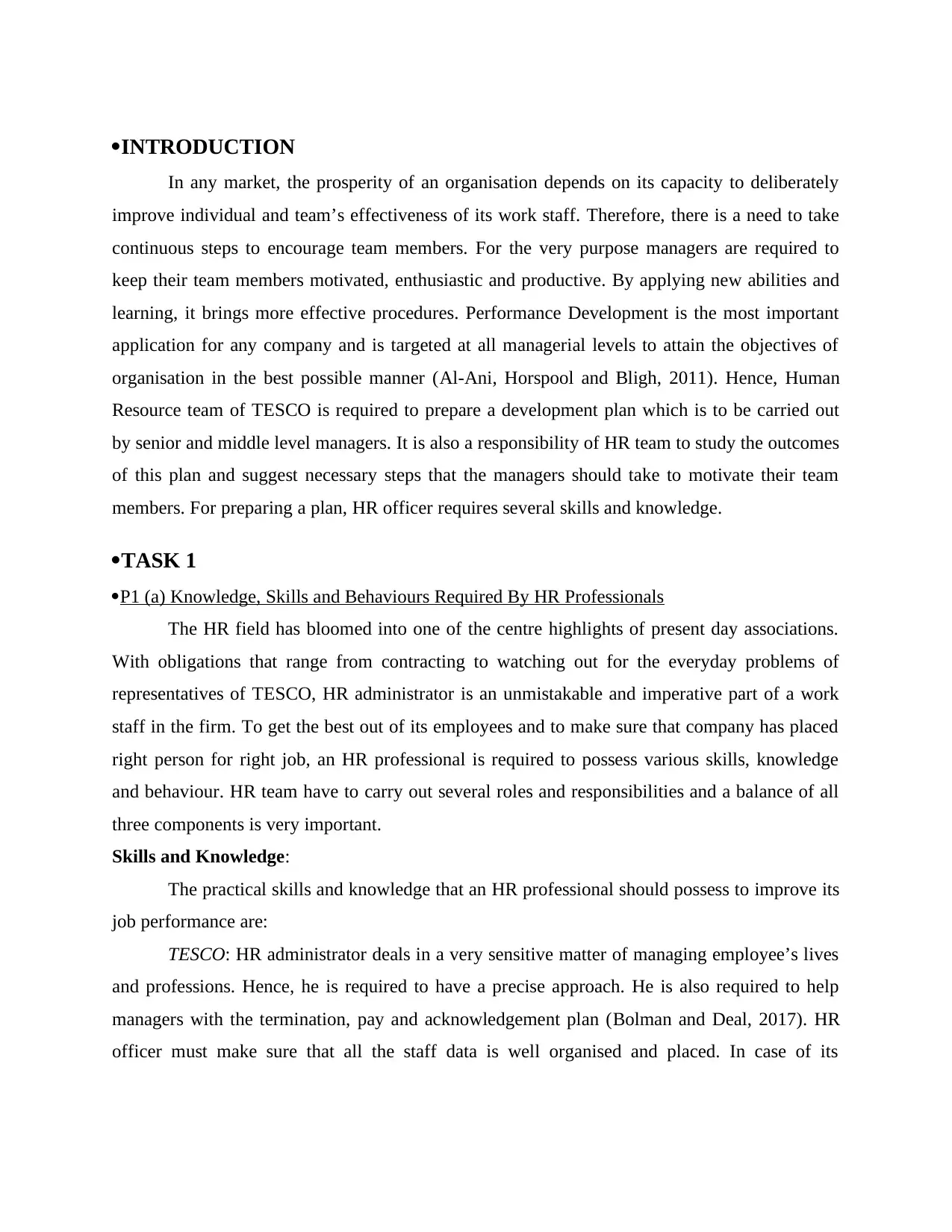
·INTRODUCTION
In any market, the prosperity of an organisation depends on its capacity to deliberately
improve individual and team’s effectiveness of its work staff. Therefore, there is a need to take
continuous steps to encourage team members. For the very purpose managers are required to
keep their team members motivated, enthusiastic and productive. By applying new abilities and
learning, it brings more effective procedures. Performance Development is the most important
application for any company and is targeted at all managerial levels to attain the objectives of
organisation in the best possible manner (Al-Ani, Horspool and Bligh, 2011). Hence, Human
Resource team of TESCO is required to prepare a development plan which is to be carried out
by senior and middle level managers. It is also a responsibility of HR team to study the outcomes
of this plan and suggest necessary steps that the managers should take to motivate their team
members. For preparing a plan, HR officer requires several skills and knowledge.
·TASK 1
·P1 (a) Knowledge, Skills and Behaviours Required By HR Professionals
The HR field has bloomed into one of the centre highlights of present day associations.
With obligations that range from contracting to watching out for the everyday problems of
representatives of TESCO, HR administrator is an unmistakable and imperative part of a work
staff in the firm. To get the best out of its employees and to make sure that company has placed
right person for right job, an HR professional is required to possess various skills, knowledge
and behaviour. HR team have to carry out several roles and responsibilities and a balance of all
three components is very important.
Skills and Knowledge:
The practical skills and knowledge that an HR professional should possess to improve its
job performance are:
TESCO: HR administrator deals in a very sensitive matter of managing employee’s lives
and professions. Hence, he is required to have a precise approach. He is also required to help
managers with the termination, pay and acknowledgement plan (Bolman and Deal, 2017). HR
officer must make sure that all the staff data is well organised and placed. In case of its
In any market, the prosperity of an organisation depends on its capacity to deliberately
improve individual and team’s effectiveness of its work staff. Therefore, there is a need to take
continuous steps to encourage team members. For the very purpose managers are required to
keep their team members motivated, enthusiastic and productive. By applying new abilities and
learning, it brings more effective procedures. Performance Development is the most important
application for any company and is targeted at all managerial levels to attain the objectives of
organisation in the best possible manner (Al-Ani, Horspool and Bligh, 2011). Hence, Human
Resource team of TESCO is required to prepare a development plan which is to be carried out
by senior and middle level managers. It is also a responsibility of HR team to study the outcomes
of this plan and suggest necessary steps that the managers should take to motivate their team
members. For preparing a plan, HR officer requires several skills and knowledge.
·TASK 1
·P1 (a) Knowledge, Skills and Behaviours Required By HR Professionals
The HR field has bloomed into one of the centre highlights of present day associations.
With obligations that range from contracting to watching out for the everyday problems of
representatives of TESCO, HR administrator is an unmistakable and imperative part of a work
staff in the firm. To get the best out of its employees and to make sure that company has placed
right person for right job, an HR professional is required to possess various skills, knowledge
and behaviour. HR team have to carry out several roles and responsibilities and a balance of all
three components is very important.
Skills and Knowledge:
The practical skills and knowledge that an HR professional should possess to improve its
job performance are:
TESCO: HR administrator deals in a very sensitive matter of managing employee’s lives
and professions. Hence, he is required to have a precise approach. He is also required to help
managers with the termination, pay and acknowledgement plan (Bolman and Deal, 2017). HR
officer must make sure that all the staff data is well organised and placed. In case of its
Paraphrase This Document
Need a fresh take? Get an instant paraphrase of this document with our AI Paraphraser
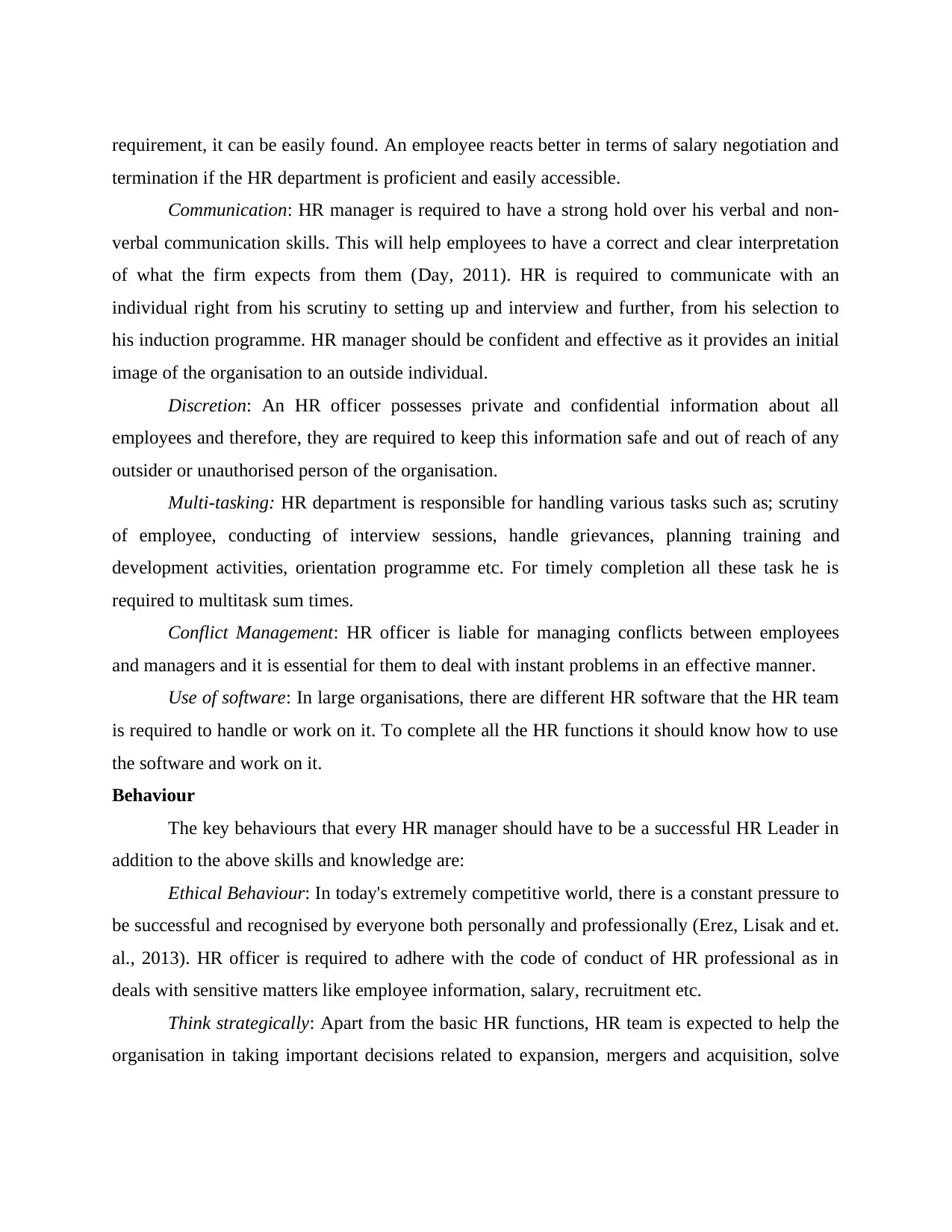
requirement, it can be easily found. An employee reacts better in terms of salary negotiation and
termination if the HR department is proficient and easily accessible.
Communication: HR manager is required to have a strong hold over his verbal and non-
verbal communication skills. This will help employees to have a correct and clear interpretation
of what the firm expects from them (Day, 2011). HR is required to communicate with an
individual right from his scrutiny to setting up and interview and further, from his selection to
his induction programme. HR manager should be confident and effective as it provides an initial
image of the organisation to an outside individual.
Discretion: An HR officer possesses private and confidential information about all
employees and therefore, they are required to keep this information safe and out of reach of any
outsider or unauthorised person of the organisation.
Multi-tasking: HR department is responsible for handling various tasks such as; scrutiny
of employee, conducting of interview sessions, handle grievances, planning training and
development activities, orientation programme etc. For timely completion all these task he is
required to multitask sum times.
Conflict Management: HR officer is liable for managing conflicts between employees
and managers and it is essential for them to deal with instant problems in an effective manner.
Use of software: In large organisations, there are different HR software that the HR team
is required to handle or work on it. To complete all the HR functions it should know how to use
the software and work on it.
Behaviour
The key behaviours that every HR manager should have to be a successful HR Leader in
addition to the above skills and knowledge are:
Ethical Behaviour: In today's extremely competitive world, there is a constant pressure to
be successful and recognised by everyone both personally and professionally (Erez, Lisak and et.
al., 2013). HR officer is required to adhere with the code of conduct of HR professional as in
deals with sensitive matters like employee information, salary, recruitment etc.
Think strategically: Apart from the basic HR functions, HR team is expected to help the
organisation in taking important decisions related to expansion, mergers and acquisition, solve
termination if the HR department is proficient and easily accessible.
Communication: HR manager is required to have a strong hold over his verbal and non-
verbal communication skills. This will help employees to have a correct and clear interpretation
of what the firm expects from them (Day, 2011). HR is required to communicate with an
individual right from his scrutiny to setting up and interview and further, from his selection to
his induction programme. HR manager should be confident and effective as it provides an initial
image of the organisation to an outside individual.
Discretion: An HR officer possesses private and confidential information about all
employees and therefore, they are required to keep this information safe and out of reach of any
outsider or unauthorised person of the organisation.
Multi-tasking: HR department is responsible for handling various tasks such as; scrutiny
of employee, conducting of interview sessions, handle grievances, planning training and
development activities, orientation programme etc. For timely completion all these task he is
required to multitask sum times.
Conflict Management: HR officer is liable for managing conflicts between employees
and managers and it is essential for them to deal with instant problems in an effective manner.
Use of software: In large organisations, there are different HR software that the HR team
is required to handle or work on it. To complete all the HR functions it should know how to use
the software and work on it.
Behaviour
The key behaviours that every HR manager should have to be a successful HR Leader in
addition to the above skills and knowledge are:
Ethical Behaviour: In today's extremely competitive world, there is a constant pressure to
be successful and recognised by everyone both personally and professionally (Erez, Lisak and et.
al., 2013). HR officer is required to adhere with the code of conduct of HR professional as in
deals with sensitive matters like employee information, salary, recruitment etc.
Think strategically: Apart from the basic HR functions, HR team is expected to help the
organisation in taking important decisions related to expansion, mergers and acquisition, solve
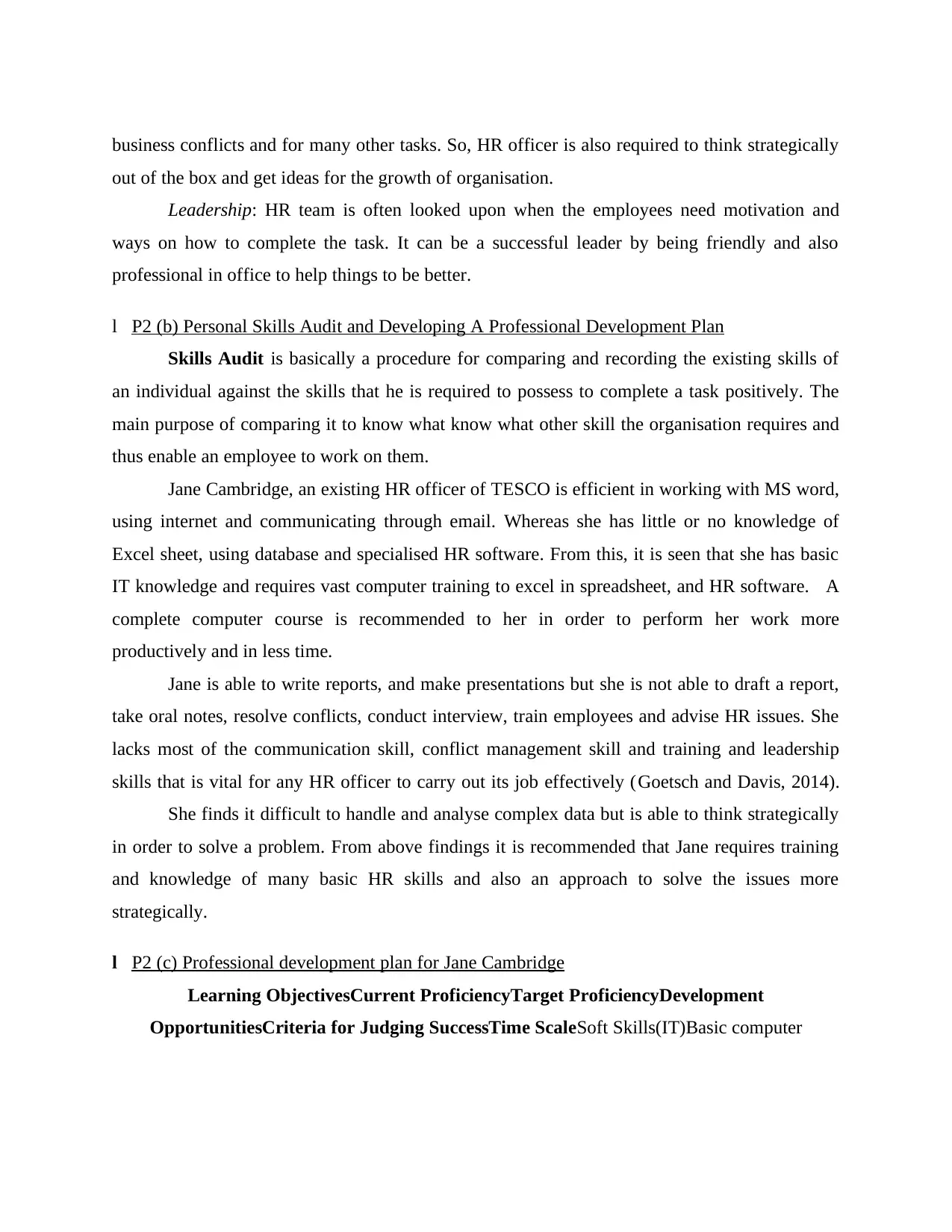
business conflicts and for many other tasks. So, HR officer is also required to think strategically
out of the box and get ideas for the growth of organisation.
Leadership: HR team is often looked upon when the employees need motivation and
ways on how to complete the task. It can be a successful leader by being friendly and also
professional in office to help things to be better.
l壱P2 (b) Personal Skills Audit and Developing A Professional Development Plan
Skills Audit is basically a procedure for comparing and recording the existing skills of
an individual against the skills that he is required to possess to complete a task positively. The
main purpose of comparing it to know what know what other skill the organisation requires and
thus enable an employee to work on them.
Jane Cambridge, an existing HR officer of TESCO is efficient in working with MS word,
using internet and communicating through email. Whereas she has little or no knowledge of
Excel sheet, using database and specialised HR software. From this, it is seen that she has basic
IT knowledge and requires vast computer training to excel in spreadsheet, and HR software. A
complete computer course is recommended to her in order to perform her work more
productively and in less time.
Jane is able to write reports, and make presentations but she is not able to draft a report,
take oral notes, resolve conflicts, conduct interview, train employees and advise HR issues. She
lacks most of the communication skill, conflict management skill and training and leadership
skills that is vital for any HR officer to carry out its job effectively (Goetsch and Davis, 2014).
She finds it difficult to handle and analyse complex data but is able to think strategically
in order to solve a problem. From above findings it is recommended that Jane requires training
and knowledge of many basic HR skills and also an approach to solve the issues more
strategically.
l壱P2 (c) Professional development plan for Jane Cambridge
Learning ObjectivesCurrent ProficiencyTarget ProficiencyDevelopment
OpportunitiesCriteria for Judging SuccessTime ScaleSoft Skills(IT)Basic computer
out of the box and get ideas for the growth of organisation.
Leadership: HR team is often looked upon when the employees need motivation and
ways on how to complete the task. It can be a successful leader by being friendly and also
professional in office to help things to be better.
l壱P2 (b) Personal Skills Audit and Developing A Professional Development Plan
Skills Audit is basically a procedure for comparing and recording the existing skills of
an individual against the skills that he is required to possess to complete a task positively. The
main purpose of comparing it to know what know what other skill the organisation requires and
thus enable an employee to work on them.
Jane Cambridge, an existing HR officer of TESCO is efficient in working with MS word,
using internet and communicating through email. Whereas she has little or no knowledge of
Excel sheet, using database and specialised HR software. From this, it is seen that she has basic
IT knowledge and requires vast computer training to excel in spreadsheet, and HR software. A
complete computer course is recommended to her in order to perform her work more
productively and in less time.
Jane is able to write reports, and make presentations but she is not able to draft a report,
take oral notes, resolve conflicts, conduct interview, train employees and advise HR issues. She
lacks most of the communication skill, conflict management skill and training and leadership
skills that is vital for any HR officer to carry out its job effectively (Goetsch and Davis, 2014).
She finds it difficult to handle and analyse complex data but is able to think strategically
in order to solve a problem. From above findings it is recommended that Jane requires training
and knowledge of many basic HR skills and also an approach to solve the issues more
strategically.
l壱P2 (c) Professional development plan for Jane Cambridge
Learning ObjectivesCurrent ProficiencyTarget ProficiencyDevelopment
OpportunitiesCriteria for Judging SuccessTime ScaleSoft Skills(IT)Basic computer
⊘ This is a preview!⊘
Do you want full access?
Subscribe today to unlock all pages.

Trusted by 1+ million students worldwide
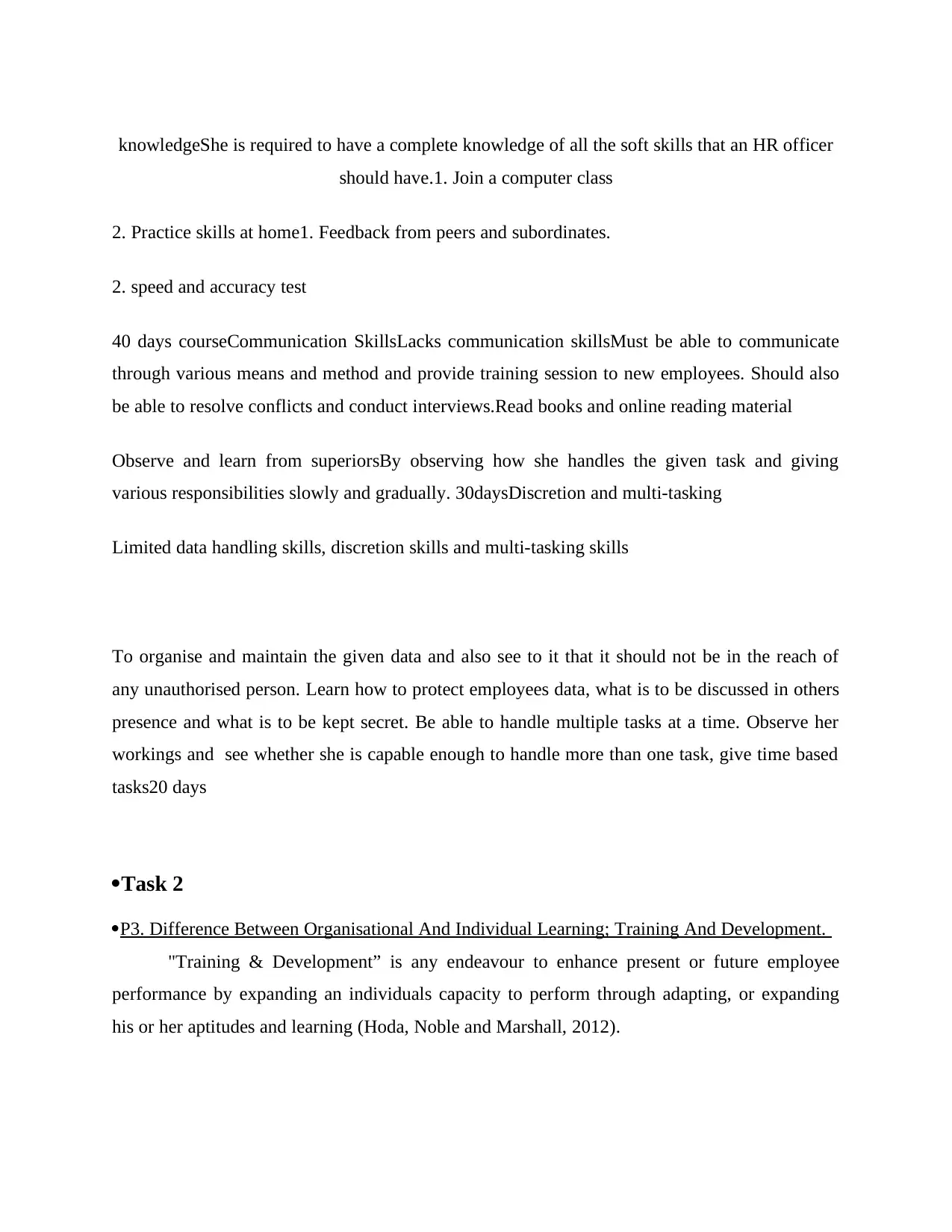
knowledgeShe is required to have a complete knowledge of all the soft skills that an HR officer
should have.1. Join a computer class
2. Practice skills at home1. Feedback from peers and subordinates.
2. speed and accuracy test
40 days courseCommunication SkillsLacks communication skillsMust be able to communicate
through various means and method and provide training session to new employees. Should also
be able to resolve conflicts and conduct interviews.Read books and online reading material
Observe and learn from superiorsBy observing how she handles the given task and giving
various responsibilities slowly and gradually. 30daysDiscretion and multi-tasking
Limited data handling skills, discretion skills and multi-tasking skills
To organise and maintain the given data and also see to it that it should not be in the reach of
any unauthorised person. Learn how to protect employees data, what is to be discussed in others
presence and what is to be kept secret. Be able to handle multiple tasks at a time. Observe her
workings and see whether she is capable enough to handle more than one task, give time based
tasks20 days
·Task 2
·P3. Difference Between Organisational And Individual Learning; Training And Development.
"Training & Development” is any endeavour to enhance present or future employee
performance by expanding an individuals capacity to perform through adapting, or expanding
his or her aptitudes and learning (Hoda, Noble and Marshall, 2012).
should have.1. Join a computer class
2. Practice skills at home1. Feedback from peers and subordinates.
2. speed and accuracy test
40 days courseCommunication SkillsLacks communication skillsMust be able to communicate
through various means and method and provide training session to new employees. Should also
be able to resolve conflicts and conduct interviews.Read books and online reading material
Observe and learn from superiorsBy observing how she handles the given task and giving
various responsibilities slowly and gradually. 30daysDiscretion and multi-tasking
Limited data handling skills, discretion skills and multi-tasking skills
To organise and maintain the given data and also see to it that it should not be in the reach of
any unauthorised person. Learn how to protect employees data, what is to be discussed in others
presence and what is to be kept secret. Be able to handle multiple tasks at a time. Observe her
workings and see whether she is capable enough to handle more than one task, give time based
tasks20 days
·Task 2
·P3. Difference Between Organisational And Individual Learning; Training And Development.
"Training & Development” is any endeavour to enhance present or future employee
performance by expanding an individuals capacity to perform through adapting, or expanding
his or her aptitudes and learning (Hoda, Noble and Marshall, 2012).
Paraphrase This Document
Need a fresh take? Get an instant paraphrase of this document with our AI Paraphraser
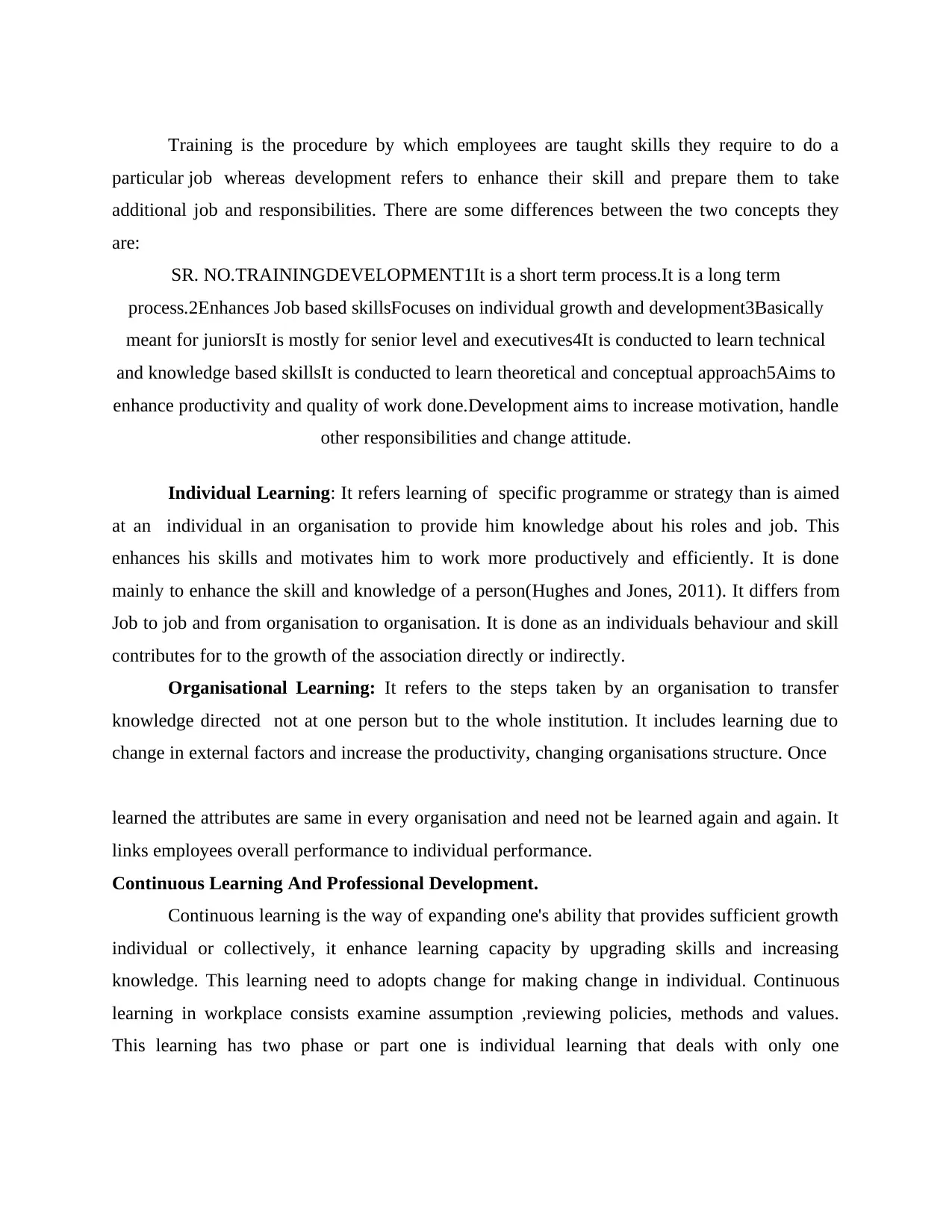
Training is the procedure by which employees are taught skills they require to do a
particular job whereas development refers to enhance their skill and prepare them to take
additional job and responsibilities. There are some differences between the two concepts they
are:
SR. NO.TRAININGDEVELOPMENT1It is a short term process.It is a long term
process.2Enhances Job based skillsFocuses on individual growth and development3Basically
meant for juniorsIt is mostly for senior level and executives4It is conducted to learn technical
and knowledge based skillsIt is conducted to learn theoretical and conceptual approach5Aims to
enhance productivity and quality of work done.Development aims to increase motivation, handle
other responsibilities and change attitude.
Individual Learning: It refers learning of specific programme or strategy than is aimed
at an individual in an organisation to provide him knowledge about his roles and job. This
enhances his skills and motivates him to work more productively and efficiently. It is done
mainly to enhance the skill and knowledge of a person(Hughes and Jones, 2011). It differs from
Job to job and from organisation to organisation. It is done as an individuals behaviour and skill
contributes for to the growth of the association directly or indirectly.
Organisational Learning: It refers to the steps taken by an organisation to transfer
knowledge directed not at one person but to the whole institution. It includes learning due to
change in external factors and increase the productivity, changing organisations structure. Once
learned the attributes are same in every organisation and need not be learned again and again. It
links employees overall performance to individual performance.
Continuous Learning And Professional Development.
Continuous learning is the way of expanding one's ability that provides sufficient growth
individual or collectively, it enhance learning capacity by upgrading skills and increasing
knowledge. This learning need to adopts change for making change in individual. Continuous
learning in workplace consists examine assumption ,reviewing policies, methods and values.
This learning has two phase or part one is individual learning that deals with only one
particular job whereas development refers to enhance their skill and prepare them to take
additional job and responsibilities. There are some differences between the two concepts they
are:
SR. NO.TRAININGDEVELOPMENT1It is a short term process.It is a long term
process.2Enhances Job based skillsFocuses on individual growth and development3Basically
meant for juniorsIt is mostly for senior level and executives4It is conducted to learn technical
and knowledge based skillsIt is conducted to learn theoretical and conceptual approach5Aims to
enhance productivity and quality of work done.Development aims to increase motivation, handle
other responsibilities and change attitude.
Individual Learning: It refers learning of specific programme or strategy than is aimed
at an individual in an organisation to provide him knowledge about his roles and job. This
enhances his skills and motivates him to work more productively and efficiently. It is done
mainly to enhance the skill and knowledge of a person(Hughes and Jones, 2011). It differs from
Job to job and from organisation to organisation. It is done as an individuals behaviour and skill
contributes for to the growth of the association directly or indirectly.
Organisational Learning: It refers to the steps taken by an organisation to transfer
knowledge directed not at one person but to the whole institution. It includes learning due to
change in external factors and increase the productivity, changing organisations structure. Once
learned the attributes are same in every organisation and need not be learned again and again. It
links employees overall performance to individual performance.
Continuous Learning And Professional Development.
Continuous learning is the way of expanding one's ability that provides sufficient growth
individual or collectively, it enhance learning capacity by upgrading skills and increasing
knowledge. This learning need to adopts change for making change in individual. Continuous
learning in workplace consists examine assumption ,reviewing policies, methods and values.
This learning has two phase or part one is individual learning that deals with only one
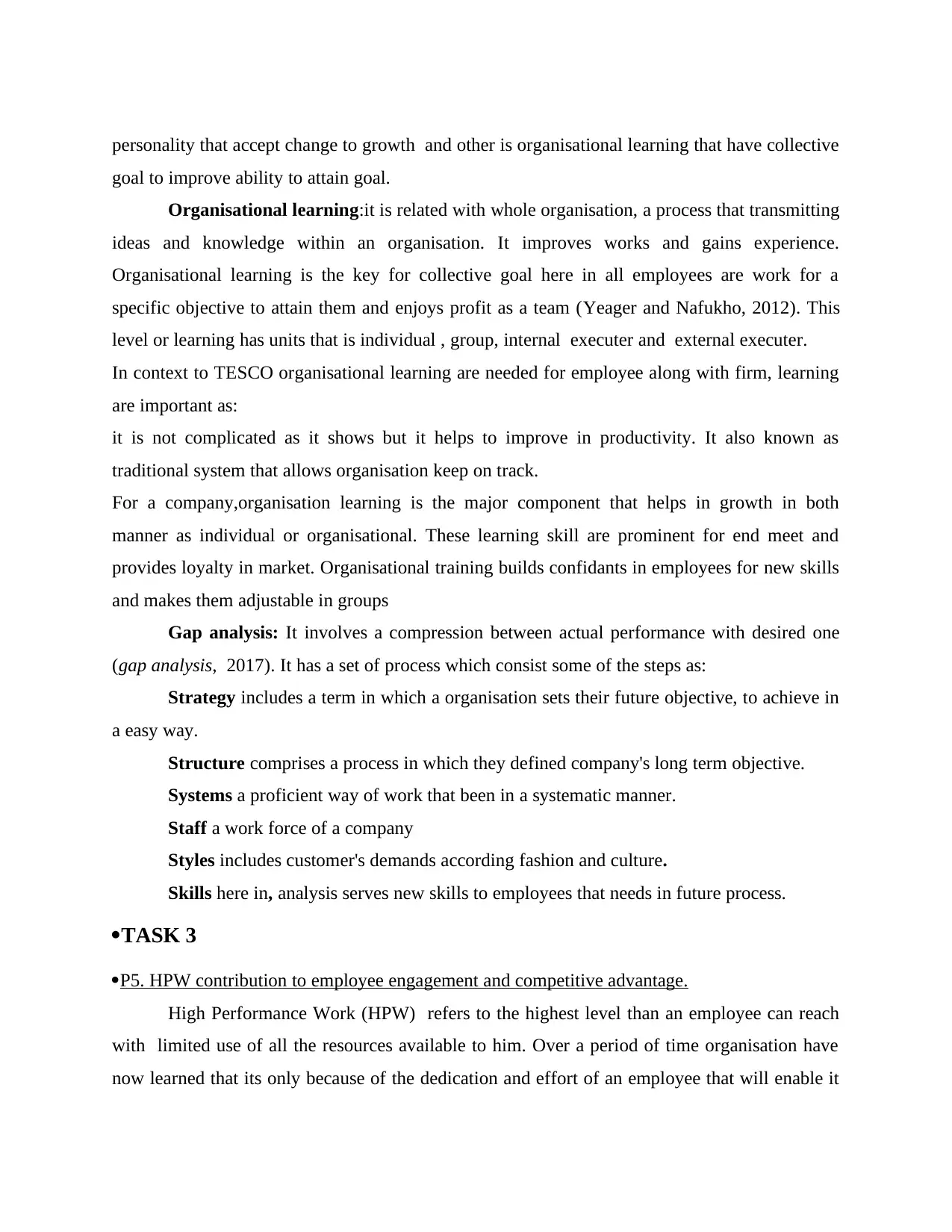
personality that accept change to growth and other is organisational learning that have collective
goal to improve ability to attain goal.
Organisational learning:it is related with whole organisation, a process that transmitting
ideas and knowledge within an organisation. It improves works and gains experience.
Organisational learning is the key for collective goal here in all employees are work for a
specific objective to attain them and enjoys profit as a team (Yeager and Nafukho, 2012). This
level or learning has units that is individual , group, internal executer and external executer.
In context to TESCO organisational learning are needed for employee along with firm, learning
are important as:
it is not complicated as it shows but it helps to improve in productivity. It also known as
traditional system that allows organisation keep on track.
For a company,organisation learning is the major component that helps in growth in both
manner as individual or organisational. These learning skill are prominent for end meet and
provides loyalty in market. Organisational training builds confidants in employees for new skills
and makes them adjustable in groups
Gap analysis: It involves a compression between actual performance with desired one
(gap analysis, 2017). It has a set of process which consist some of the steps as:
Strategy includes a term in which a organisation sets their future objective, to achieve in
a easy way.
Structure comprises a process in which they defined company's long term objective.
Systems a proficient way of work that been in a systematic manner.
Staff a work force of a company
Styles includes customer's demands according fashion and culture.
Skills here in, analysis serves new skills to employees that needs in future process.
·TASK 3
·P5. HPW contribution to employee engagement and competitive advantage.
High Performance Work (HPW) refers to the highest level than an employee can reach
with limited use of all the resources available to him. Over a period of time organisation have
now learned that its only because of the dedication and effort of an employee that will enable it
goal to improve ability to attain goal.
Organisational learning:it is related with whole organisation, a process that transmitting
ideas and knowledge within an organisation. It improves works and gains experience.
Organisational learning is the key for collective goal here in all employees are work for a
specific objective to attain them and enjoys profit as a team (Yeager and Nafukho, 2012). This
level or learning has units that is individual , group, internal executer and external executer.
In context to TESCO organisational learning are needed for employee along with firm, learning
are important as:
it is not complicated as it shows but it helps to improve in productivity. It also known as
traditional system that allows organisation keep on track.
For a company,organisation learning is the major component that helps in growth in both
manner as individual or organisational. These learning skill are prominent for end meet and
provides loyalty in market. Organisational training builds confidants in employees for new skills
and makes them adjustable in groups
Gap analysis: It involves a compression between actual performance with desired one
(gap analysis, 2017). It has a set of process which consist some of the steps as:
Strategy includes a term in which a organisation sets their future objective, to achieve in
a easy way.
Structure comprises a process in which they defined company's long term objective.
Systems a proficient way of work that been in a systematic manner.
Staff a work force of a company
Styles includes customer's demands according fashion and culture.
Skills here in, analysis serves new skills to employees that needs in future process.
·TASK 3
·P5. HPW contribution to employee engagement and competitive advantage.
High Performance Work (HPW) refers to the highest level than an employee can reach
with limited use of all the resources available to him. Over a period of time organisation have
now learned that its only because of the dedication and effort of an employee that will enable it
⊘ This is a preview!⊘
Do you want full access?
Subscribe today to unlock all pages.

Trusted by 1+ million students worldwide
1 out of 18
Related Documents
Your All-in-One AI-Powered Toolkit for Academic Success.
+13062052269
info@desklib.com
Available 24*7 on WhatsApp / Email
![[object Object]](/_next/static/media/star-bottom.7253800d.svg)
Unlock your academic potential
Copyright © 2020–2025 A2Z Services. All Rights Reserved. Developed and managed by ZUCOL.





